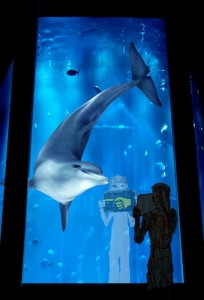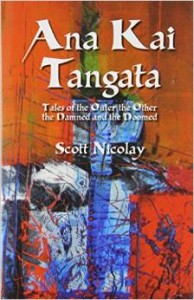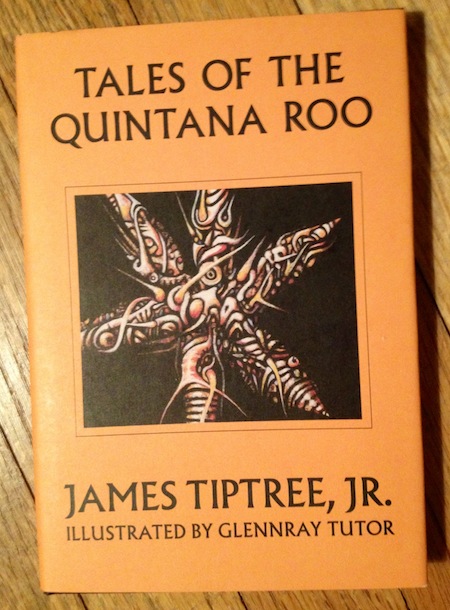 Nothing is what it seems to be chez Tiptree, least of all, Tiptree. Don’t think for a moment that knowing their legal name was Alice Sheldon, AKA Raccoona, AKA Alli, leaves you on any solid ground. Our subject is a psychologist who helped forge the modern CIA from the disjointed remnants of the OSS—and who was still leaking classified information in their first novel over a decade after they supposedly left The Agency. They must have been a regular terror at the old “tell me three things about yourself, one of which is a lie” game. Consider how well a CIA psychologist could fuck with your mind. After they pinched a pseudonym from a venerable UK manufacturer of marmalades they found they could fuck with more minds than ever through the medium of fiction. Continue reading
Nothing is what it seems to be chez Tiptree, least of all, Tiptree. Don’t think for a moment that knowing their legal name was Alice Sheldon, AKA Raccoona, AKA Alli, leaves you on any solid ground. Our subject is a psychologist who helped forge the modern CIA from the disjointed remnants of the OSS—and who was still leaking classified information in their first novel over a decade after they supposedly left The Agency. They must have been a regular terror at the old “tell me three things about yourself, one of which is a lie” game. Consider how well a CIA psychologist could fuck with your mind. After they pinched a pseudonym from a venerable UK manufacturer of marmalades they found they could fuck with more minds than ever through the medium of fiction. Continue reading
Scott Nicolay
Ana Kai Tangata
Tag: Science Fiction (page 2 of 3)
There’s no one quite like Henry Lien in spec-lit today. He has generated major buzz with just six unique stories. His first published story ‘Pearl Rehabilitative Colony for Ungrateful Daughters’, which features “an art form that combines figure skating with kung fu”, made the cover of the December 2013 issue of Asimov’s Science Fiction (Henry even pitched cover artist Alexandra Manukyan) and went on to be a Nebula Award nominee. His latest, critically acclaimed ‘The Ladies’ Aquatic Gardening Society’ (Asimov’s, June 2015), perhaps his most distinctly Weird tale, is about two Gilded Age grandes dames dueling for Newport high society dominance via their increasingly outrageous and environmentally devastating theme gardens. On this episode of The Outer Dark, Henry pulls back the curtain on his creative process starting with the rigorous questions he asks himself before moving forward with an idea (0:03:00), diving into stories as “thought experiments”, putting pressure on his writing and matching concept with format, the importance of humor in “humanizing” and “bridging centuries and miles”, the potential for “wonder in modest concepts” and exploring them to their logical conclusion and how he pushes outside himself to tell stories from the viewpoint of girls and women. A self-described “one-man movie studio”, he also waxes enthusiastic about the joy he gets from indulging his multimedia muse including the “crazy fun” and “intense satisfaction” of handing a story over to an artist, voicing his characters in audio rendition, and even dabbling in writing music to accompany his stories. The madcap conversa
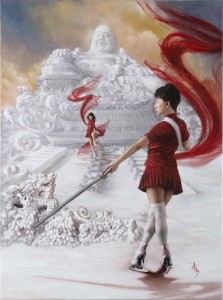
“Pearl Rehabilitative Colony for Ungrateful Daughters” (Cover story, Asimov’s, Dec. 2013). Art by Alexandra Manukyan.
tion touches upon all his stories from the two aforementioned tales (‘Pearl’, 0:14:45) (‘Ladies’, 1:01:30)to the simple, elegant, tragic ‘Supplemental Declaration of Henry Lien’ (Interfictions, Nov. 2015)(0:24:30) and the life-changing experience at its heart that propelled him into writing spec-lit, the poignant dolphin conservation advocacy tale ‘Bilingual’ (F&SF, March 2015) (0:34:55) told unexpectedly all via Twitter, ‘The Shadow You Cast Is Me’ (Lady Churchill’s Rosebud Wristlet, May 2015) (1:38:30) in which he explores the uncomfortable topic of a dysfunctional marriage, and ‘The Great Leap of Shin’ (Analog, Jan. 2015) (1:50:45). His Clarion West instructors Chuck Palahniuk and George RR Martin receive some heartfelt appreciation, “worlds that can be held in a pocket” are mused upon, and there’s a Karel Čapek interlude (1:17:00), plus ruminations on the rapidly diversifying audience for spec-lit, why Henry is done with short stories for the time-being, his just-completed novel which he says is “the best thing I have written”, why it’s OK to be proud of your stories, why he supports bringing back legal dueling to resolve world conflicts (1:51:30), his own ultimate duels, his ‘Radio SFWA’ recruitment anthem performed at the 2016 Nebula Awards (2:00:00), and his recommended living authors (2:05:20) James Robert Herndon
and Lian Hearn.
News From the Weird
(2:13:10) With Arkham Digest columnist and Strange Aeons fiction editor Justin “Steely J” Steele. Reviews of two of the best weird fiction chapbooks of 2015: These Last Embers by Simon Strantzas, from Undertow Publications, and The Visible Filth by Nathan Ballingrud, from This is Horror.All day Levitra is great and works fine. Plus Scott and Justin look ahead to 2016, which promises to be another big year in the Weird including another author reveal from the table of contents of the much anticipated Lost Signals anthology (ed. Max Booth III/Perpetual Motion Machine Press).
This archival episode is available at This Is Horror here.
Additional Links
‘Swim Wants to Know if it’s as Bad as Swim Thinks’ by Paul Tremblay
Show credits
Host/Executive Producer: Scott Nicolay
Co-Host, News From the Weird: Justin Steele
Associate Producer/Show Notes: Anya Martin
Logo Design: Nick “The Hat” Gucker
Music: Michael Griffin
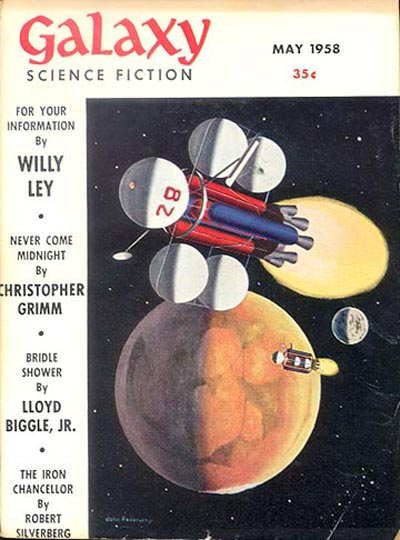 When Michael Bukowski and I first conceived this series, our working title was something like “Great Weird Stories Hidden in Plain Sight.” I must take responsibility for that stillborn monstrosity, alas. Fortunately Michael suggested the much more felicitous rubric under which we debuted and now operate. I mention this here because this week’s tale exemplifies that original concept perhaps better than any other. Continue reading
When Michael Bukowski and I first conceived this series, our working title was something like “Great Weird Stories Hidden in Plain Sight.” I must take responsibility for that stillborn monstrosity, alas. Fortunately Michael suggested the much more felicitous rubric under which we debuted and now operate. I mention this here because this week’s tale exemplifies that original concept perhaps better than any other. Continue reading
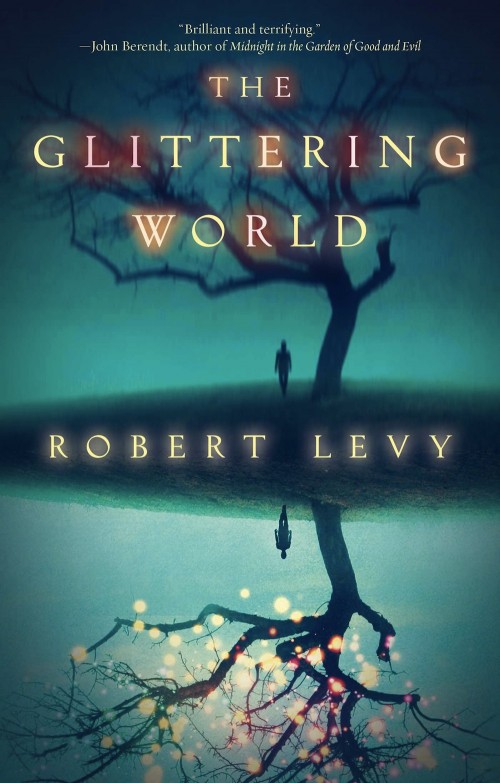 Robert Levy unveils and explores the secret origins of his novel The Glittering World from his own personal experiences in Cape Breton, Canada, or, in other words, “taking a great memory and completely destroying it,” similarities between the old lore behind fairies and alien abduction mythology, his ambivalence about but recognition of genre marketing in the publishing business, how a genre-defying and Weird first novel got placed with a major publisher, other authors like Jeff VanderMeer and Paul Tremblay who are breaking the Weird into big publishing, structural similarities in The Glittering World to two Alfred Hitchcock classics, the Weird’s transition from shorter modes into the novel, the short story and novels as different forms, how the book sheds its skin as the main characters unfold the narrative akin to a four-course meal, when the glitter fades–his exploration of transitioning from the club scene fantasy lifestyle to adulthood, the title’s unexpected relationship to the tradition of Navajo emergent/creation
Robert Levy unveils and explores the secret origins of his novel The Glittering World from his own personal experiences in Cape Breton, Canada, or, in other words, “taking a great memory and completely destroying it,” similarities between the old lore behind fairies and alien abduction mythology, his ambivalence about but recognition of genre marketing in the publishing business, how a genre-defying and Weird first novel got placed with a major publisher, other authors like Jeff VanderMeer and Paul Tremblay who are breaking the Weird into big publishing, structural similarities in The Glittering World to two Alfred Hitchcock classics, the Weird’s transition from shorter modes into the novel, the short story and novels as different forms, how the book sheds its skin as the main characters unfold the narrative akin to a four-course meal, when the glitter fades–his exploration of transitioning from the club scene fantasy lifestyle to adulthood, the title’s unexpected relationship to the tradition of Navajo emergent/creation  stories, altered states as a form of escape, insects, parallels to the iconic relationship in Wuthering Heights by Emily Bronte, his fascination with people who are “right on the edge of oblivion or failure,” a stolen paperweight and life as a bizarre sequence of coincidences, storytelling as one way we try to give our life meaning, choice as the “anxiety of freedom,” taking his time to write a novel, fiction as a diary, future works which might have something to do with cults and found manuscripts, and his reading recommendations of other contemporary writers to watch including Livia Llewellyn, Desirina Boskovich, Dale Bailey, and Molly Tanzer.
stories, altered states as a form of escape, insects, parallels to the iconic relationship in Wuthering Heights by Emily Bronte, his fascination with people who are “right on the edge of oblivion or failure,” a stolen paperweight and life as a bizarre sequence of coincidences, storytelling as one way we try to give our life meaning, choice as the “anxiety of freedom,” taking his time to write a novel, fiction as a diary, future works which might have something to do with cults and found manuscripts, and his reading recommendations of other contemporary writers to watch including Livia Llewellyn, Desirina Boskovich, Dale Bailey, and Molly Tanzer.
News of the Weird Special Guest: Writer/editor Mike Allen reveals the table of contents for Clockwork Phoenix 5 in another exclusive The Outer Dark announcement.
And Justin Steele joins Scott to review The Glittering World.
This archival episode will be available again at This Is Horror soon. In the meantime, subscribe at iTunes or Blubrry to make sure you don’t miss an episode.
Next week’s guest: John C. Foster, author of the Libros de Inferno trilogy (Perpetual Motion Machine Publishing) which starts with Dead Men.
More Links:
Book trailer: https://www.youtube.com/watch?v=A7RgOVF0XG0
https://www.trailpeak.com/trail-Fairy-Hole-Hiking-Trail-Cape-Dauphin-near-Baddeck-NS-6019
Footage of the Fairy Hole cave: https://www.youtube.com/watch?v=FCZovMZlUas
Rear Window timelapse: https://vimeo.com/37120554
https://navajopeople.org/blog/navajo-creation-story-nihalgai-the-glittering-or-white-world/
https://www.amazon.com/Din%C3%A9-Bahane-Navajo-Creation-Story/dp/0826310435
November 7, 2015, World Fantasy Convention, Saratoga Springs, NY
Moderator: Thomas F. Monteleone. Panelists: Ellen Datlow, Michael Kelly, Anya Martin, Maura McHugh, Scott Nicolay
Description: When and where do they converge and converse?
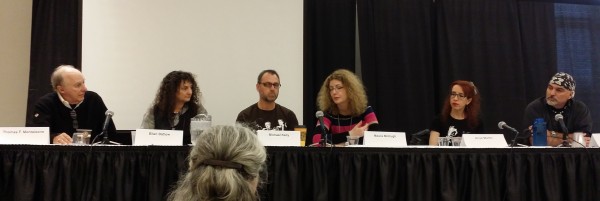 Writers and editors discuss the roots and history of Weird fiction back to Weird Tales, 19th century authors and even The Iliad, editors’ perspectives on the Weird in their own work experiences, the Weird tale as independent of tropes, early definitions of the Weird by Le Fanu as a gothic supernatural tale and Lovecraft as dread-ridden cosmic horror, its evolution to an increasingly fluid and open vision and variety in the explosion of Weird fiction today, tapping into the strangeness of reality and the element of the unexplained but why not all odd stories are weird stories, where Weird tapers and becomes surreal, whether Weird fiction needs darkness as an ingredient and when fantasy and science fiction becomes Weird, writer Gemma Files’ suggestion from the audience that the nuance may lie in how the characters react to the Weird in the story, scares versus unease, David Lynch as Weird filmmaker, why keeping a wide open definition is better for nurturing the Weird, a peek inside the editorial process behind The Year’s Best Weird Fiction and the value of changing editors every year, the growing interest in the weird outside the spec-lit community and the upcoming Wave from Hollywood and mainstream publishing, a possible danger in letting the outside world define the weird, keeping the door open as long as we can, the role of the small presses in driving the Weird explosion, Weird as a pre-existing condition, Weird fiction in the novel form, the future of Weird fiction, the recurring theme in weird fiction of the environment rising up including when the environment is a house, when ghost stories can be weird stories, the etymology of the word “Weird” in the Anglo-Saxon “Wyrd” and its many connotations including fate/destiny/transformation, why the word “Weird” is Weird itself, following the River to an inevitable destiny versus appeal of unpredictability to the reader, Jack Spicer’s Martian, and many, many recommended authors from the 19th century to now.
Writers and editors discuss the roots and history of Weird fiction back to Weird Tales, 19th century authors and even The Iliad, editors’ perspectives on the Weird in their own work experiences, the Weird tale as independent of tropes, early definitions of the Weird by Le Fanu as a gothic supernatural tale and Lovecraft as dread-ridden cosmic horror, its evolution to an increasingly fluid and open vision and variety in the explosion of Weird fiction today, tapping into the strangeness of reality and the element of the unexplained but why not all odd stories are weird stories, where Weird tapers and becomes surreal, whether Weird fiction needs darkness as an ingredient and when fantasy and science fiction becomes Weird, writer Gemma Files’ suggestion from the audience that the nuance may lie in how the characters react to the Weird in the story, scares versus unease, David Lynch as Weird filmmaker, why keeping a wide open definition is better for nurturing the Weird, a peek inside the editorial process behind The Year’s Best Weird Fiction and the value of changing editors every year, the growing interest in the weird outside the spec-lit community and the upcoming Wave from Hollywood and mainstream publishing, a possible danger in letting the outside world define the weird, keeping the door open as long as we can, the role of the small presses in driving the Weird explosion, Weird as a pre-existing condition, Weird fiction in the novel form, the future of Weird fiction, the recurring theme in weird fiction of the environment rising up including when the environment is a house, when ghost stories can be weird stories, the etymology of the word “Weird” in the Anglo-Saxon “Wyrd” and its many connotations including fate/destiny/transformation, why the word “Weird” is Weird itself, following the River to an inevitable destiny versus appeal of unpredictability to the reader, Jack Spicer’s Martian, and many, many recommended authors from the 19th century to now.
However, as these drugs cause addiction and their action becomes less expressed, Tramadol 100mg is just a step between the NSAIDs and narcotic analgesics.
Thanks to Stephen Barringer for the panel photo.
This archival episode will be available again at This Is Horror soon. In the meantime, subscribe at iTunes or Blubrry to make sure you don’t miss an episode.
More links:
https://www.hplovecraft.com/writings/texts/essays/shil.aspx
https://weirdfictionreview.com/2011/11/dogme-2011-for-weird-fiction-by-scott-nicolay/
https://weirdfictionreview.com/2014/11/the-expanding-borders-of-area-x/
Get Your Copy Today!
© 2025 Scott Nicolay
Theme by Anders Noren — Up ↑

